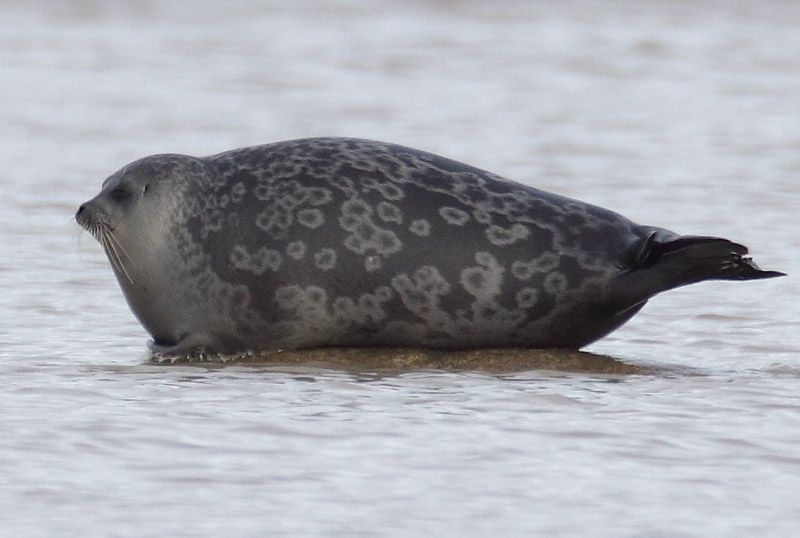Ringed seals are the smallest of the pinnipeds. The colour of their coat is variable, but it is usually dark grey on the upper parts while being light grey to silver underneath. Dark grey spots are ringed by silver or light greyish-white circles, which are clearer on the sides and back and often so close together that they fuse.
In this post, Pritish Kumar Halder takes a brief look at the RINGED SEAL, its distribution, lifestyles and different habits

Ringed seal
A Ringed seal is plump with a small, round head and a thick, short neck. Its broad, blunt snout and large, forward-facing, close-set eyes give it an appearance that is almost cat-like. The front flippers are relatively small, with slightly pointed claws of more than one inch in thickness, used for maintaining breathing holes in thick ice. Their whiskers are beaded and light-colored. Males are usually slightly larger than females.
Distribution
Ringed seals inhabit the Arctic Ocean, the Bering Sea and the Okhotsk Sea as far to the south as Japan’s northern coast in the Pacific, and the North Atlantic coastal parts of Scandinavia and Greenland and as far to the south as Newfoundland, including two freshwater subspecies which live in northern Europe. Ringed seals do not come to shore through much of their range. Instead, they live in Arctic waters and are typically found where there is pack ice and ice floes. Further south and in Lake Ladoga and Lake Saimaa these seals rest on rocks, offshore reefs and island shores when ice is absent.
Habits and Lifestyle
Ringed seals are diurnal, meaning they are active during the day. Adults are solitary except during the breeding season when they may establish their lairs closer to each other. In mid-May they begin to haul out up onto the ice to bask in the sun. They molt during this time and feed less. Ringed seals hunt on their own, and on the ice when resting they will keep away from others.
They usually stay near to holes or cracks so that they can get quickly into the water if they need to. They make lairs from snow to protect themselves. Some of the seals migrate seasonally in response to the availability of ice, and there is some evidence of migration over long distances, particularly for juveniles.
Diet and Nutrition
Ringed seals are generalists and their diet includes a range of fish, crustaceans, cephalopods, euphausiids, amphipods, mysids and shrimp.
Mating Habits
Ringed seals are polygynous, one male mating with multiple females. The breeding season is from April to May. The females build lairs amongst the thick ice where they give birth. In March or April, after gestation of 9 months, they bear a single pup. They nurse their pups for 5 to 7 weeks, and, during this time, may move their pups between lairs, usually having 4 to 6 lairs. This allows pups to move independently from shelter to shelter when they are older, if they are attacked. Females usually bear pups between the ages of 6 and 8. Males typically do not breed until they are 8 to 10 years old.
Population
Population threats
Climate change is the greatest threat to Ringed seals. Being dependent upon an ice habitat, both ice and snow need to be stable enough in the spring to allow females to raise the pups in their lairs. But as Arctic ice is continuing to melt every year and the ice breaks up sooner, mothers may increasingly become separated from their pups prematurely, which increases the risk of predation and exposure. Furthermore, warm spring temperatures and spring rains can also cause the collapse of the roofs of lairs, with similar results. Other threats to these seals are pollution, disturbance, and getting tangled in fishing nets.
Population number
According to the IUCN Red List, the world-wide population size of Ringed seals is not accurately known and can be between 1,5 and 3 million mature individuals, including five recognized subspecies: Arctic Ringed Seal – 1,450,000, Okhotsk Ringed Seal – 44,000, Baltic Ringed Seal – 11,500, Ladoga Seal – 3,000-4,500, Saimaa Seal – 135-190. The world-wide population is currently classified as Least Concern (LC) mostly due to broad distribution of Arctic Ringed Seal subspecies.
Facts
- The Ringed seal is named for the small light-colored rings or circles scattered on its back throughout the darker hair.
- The Ringed seal pup has woolly, thick, whitish fur when it is born, known as ‘lanugo’. As it grows, its fur becomes finer and a little longer than that of adults, dark gray on the upperparts, and silver on the underside. The pups are known at this stage as ‘silver jars’.
- The Ringed seal is often seen blowing bubbles while it approaches the water’s surface. This way it can check to see if a polar bear is there, which may respond to their presence. It is likely to go up for air if it doesn’t get a message that there is such a threat.
- Ringed seals live in places completely covered in ice, and so they make use of their sharp claws to form and maintain breathing holes in the ice, which may be as thick as 7 feet.
- Males’ faces are darker than those of females in the spring as the result of an oil gland secretion.






